Basic information about the field
Area: 8,56 ha
Soil type: Hummus rich sandy loam, hummus rich sand moraine
The soil type is varying in different places on the field. West end had heavy clay and east end had light sand moraine. The different soil types are affecting the choice of proper sowing time. The shape of the field is good. On the east end there is a separate “horn” (0,13 ha), which is cultivated as nature conservation field. There is a long term weed observation research going on in the field, where the amount of weeds and their affect on the yield is observed by using different kinds of mechanical control methods.
Crop rotation
2024 A: Spring wheat+grass seed, Leijona, B: silage grass
2023 Barley, Feedway
2022 Fava bean, Vire
Research and experiment
2023 Fertilizing test (Yara, Hankkija), mixed cultivation experiments (LuoVaMix)
Weed research
Year around plant coverage
Cultivation activities
Cultivation activities
Barley + experiments 3 kpl
7.5.2023 Harrowing
8.5.2023 Seedling, test A: barley Feedway, 280 kg/ha, YaraSuna 10-4-1, plot A1; 0 kg/ha, plot A2; 600kg/ha, plot A3; 800 kg/ha
8.5.2023 Sowing rest of the field, barley Feedway 256 kg/ha
12.5.2023 Sowing: LuoVaMix -lanes
13.5.2023 Fertilizer rest of the field, Neko potassium sulphate K42, 55 kg/ha
6.9.2023 Threshing, yield 2400 kg/ha
7.9.2023 Threshing, LuoVaMix -lines
Cultivation tests at the field
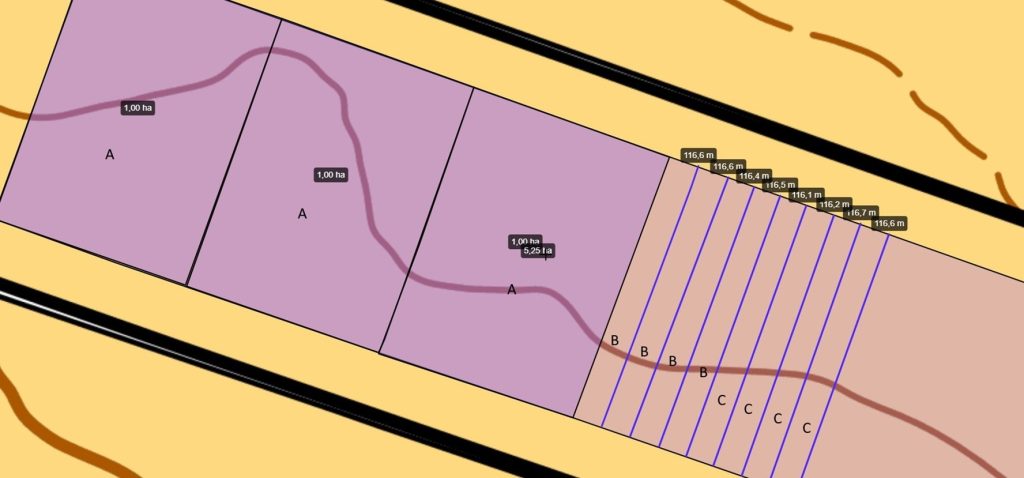
A: Recycling fertilisation test (Yara, Hankkija)
B: Fava bean + oat -line experiment (LuoVaMix)
C: Fava bean/pea + oat/wheat -line experiment (LuoVaMix)
Here you can also read the information card on organic mixed farming produced by Natural Resources Institute Finland:
Information card mixed growing in ecological production-1
A: Recycling fertilisation test
Varietal: Feedway, 256 kg/ha
Sowed: 8.5.2023
Fertilizer: Yarasuna 10-4-1
Square 1; 0 kg/ha
Square 2; 600 kg/ha
Square 3; 800 kg/ha
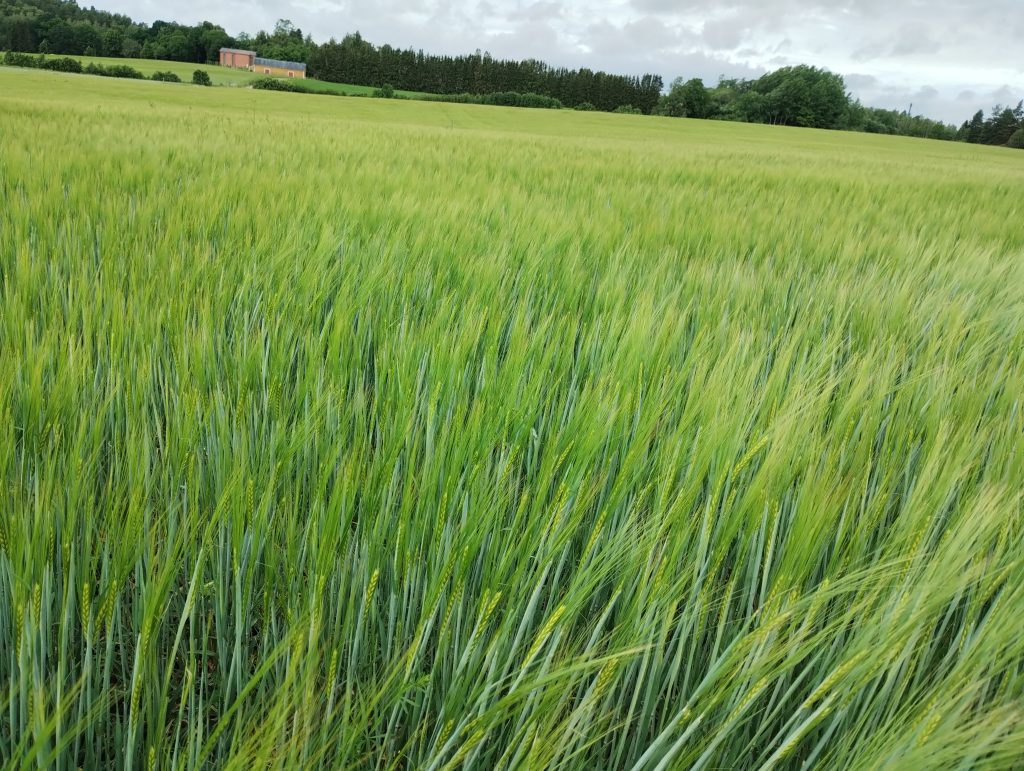
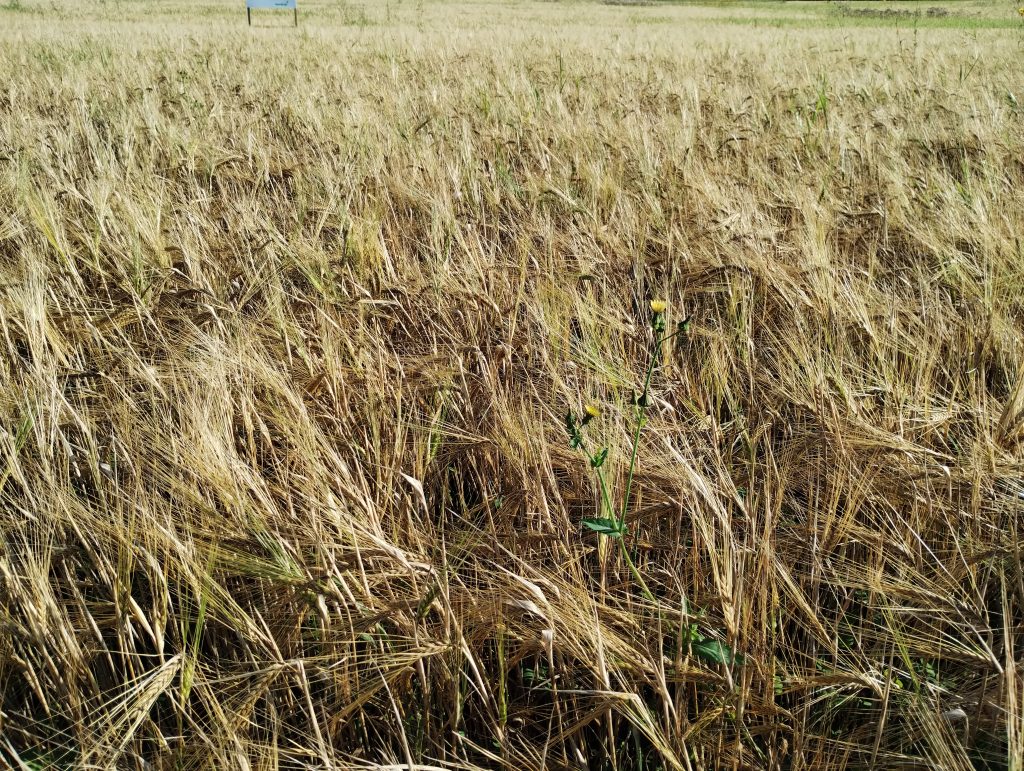
B: Fava bean and oat -line experiment
The experiment investigates the effect of different alloy ratios on crop security. The experiment has four different lanes in two repetitions.
During the growing season, the density of twigs, side shoots, weeds pcs/m2, the height of the canopy and the beginning and end of flowering were observed in the experimental plots. The broad bean was taller in the pure crops than in the mixed crops, and the oats in the pure crops were shorter than in the mixed crops. The number of cracks varied a lot in the experimental area and no clear difference between pure and mixed vegetation could be seen. The quick wheat colonies and bedstraws that hit the experimental area made it difficult to observe the breaches.
Here you can see test results
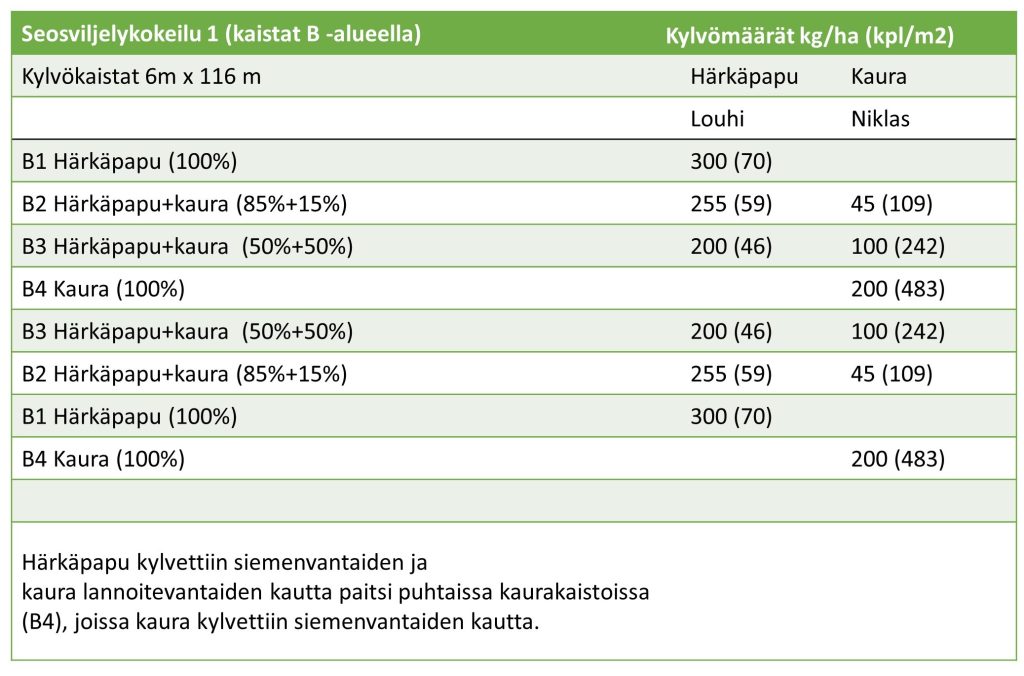
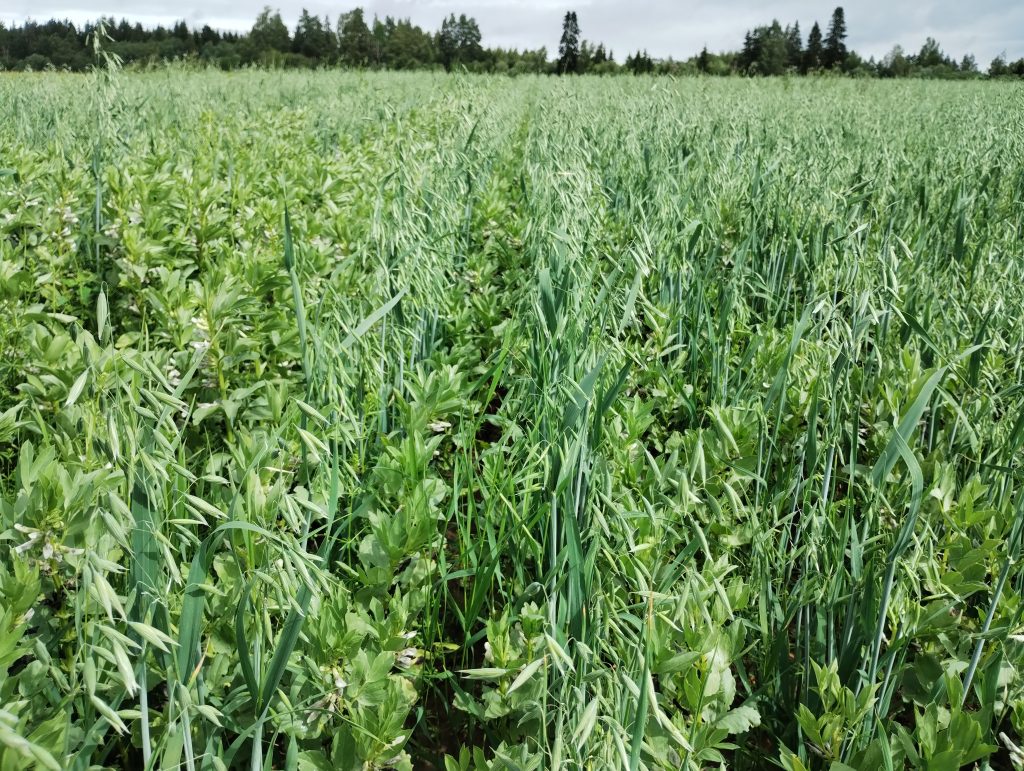
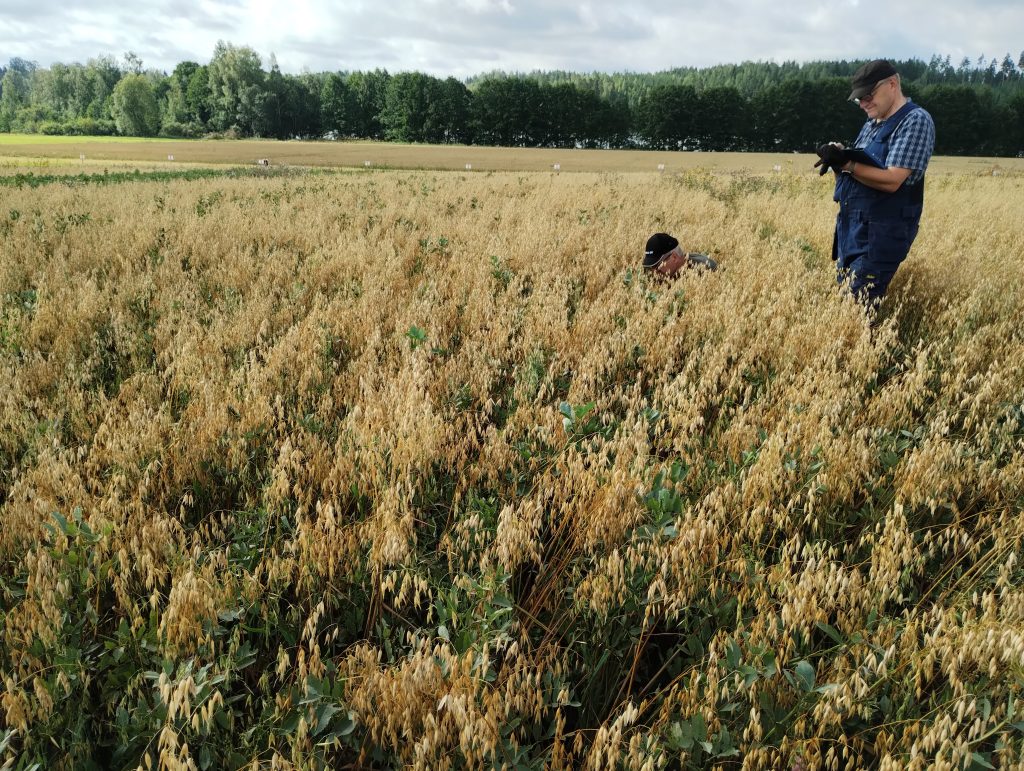
C: Protein plant + grain -line experiment
The experiment investigates the effect of different alloy ratios on crop security. In the lanes grow plants of two plants which have sowed with ordinary seeding machine by using seed and through fertilizer hoops.
During the growing season, the density of twigs, side shoots, weeds pcs/m2, the height of the canopy and the beginning and end of flowering were observed in the experimental plots. Also in this experiment, the weed colonies that hit the spot, such as sedge and common wheat, made it difficult to make weed observations, so a clear difference between the mixtures could not be observed. In the broad bean-oat mixture, both broad bean and oats grew taller than with other plants.
Here you can see test results
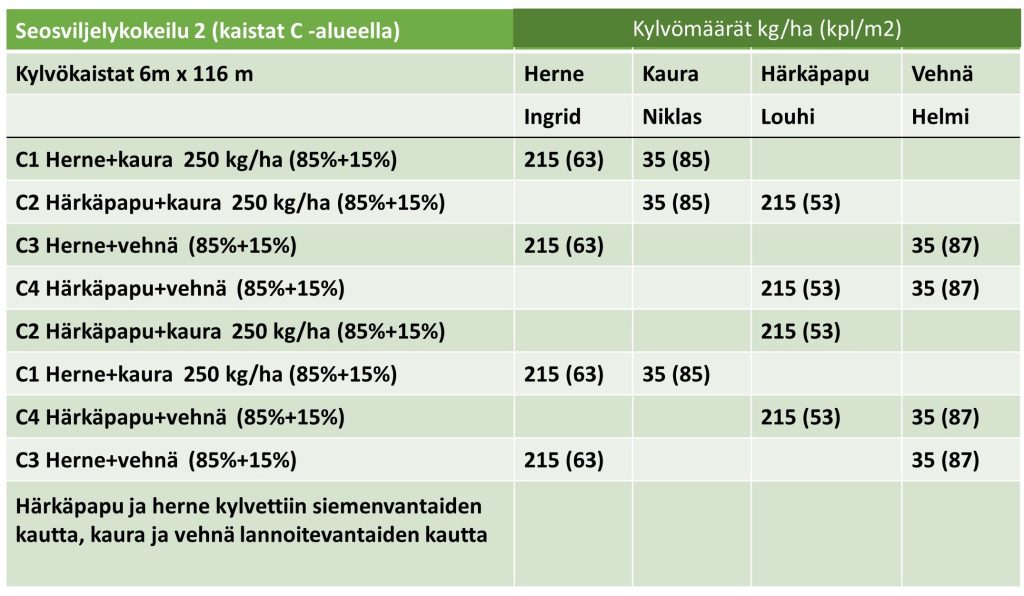
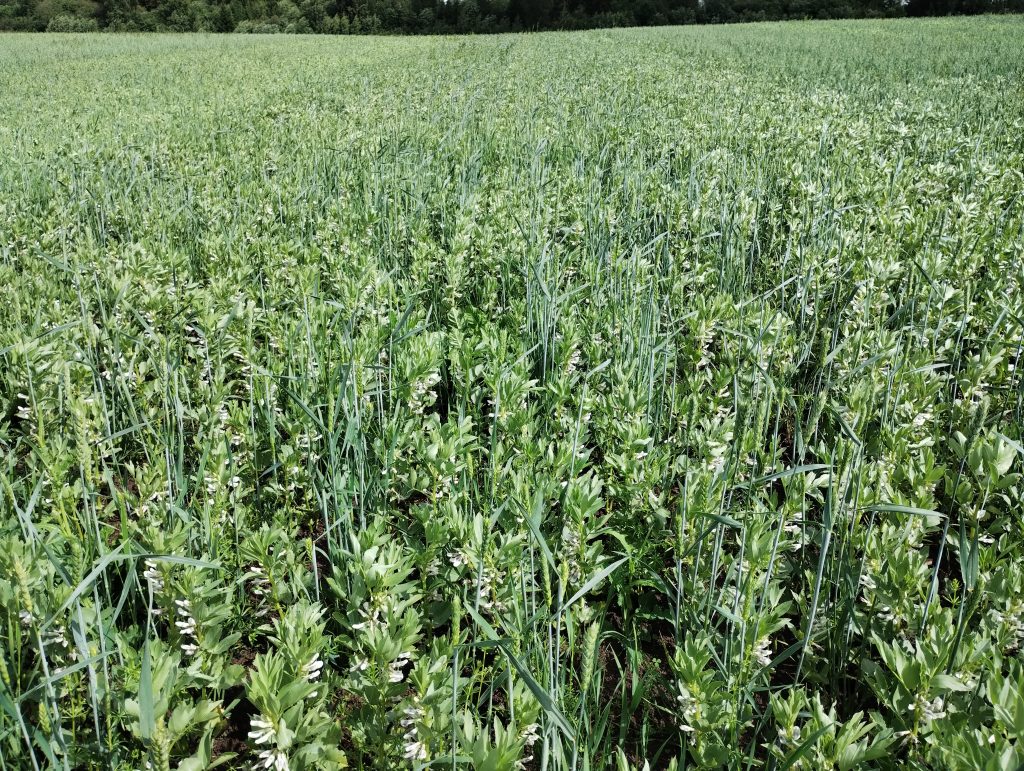
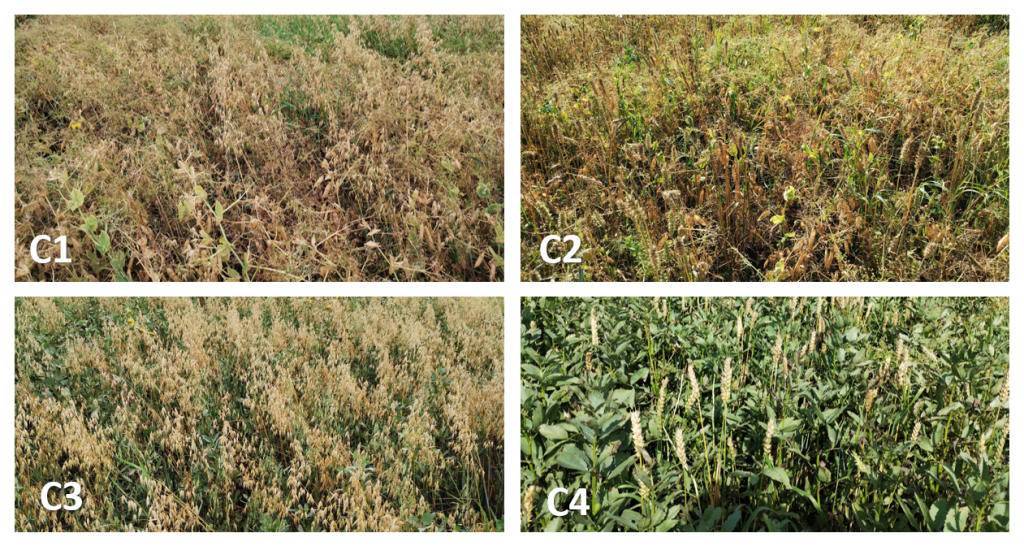
Cultivation activities
Fava bean, Vire
13.5.2022 Harrowing, goosefoot harrow
15.5.2022 Evening the soil with harrowing
16.5.2022 Sowing: fava bean Vire, English rye-grass 10 kg/ha
30.5.2022 Sowing: Canola lane
27.8.2022 Threshing, yield 1100 kg/ha
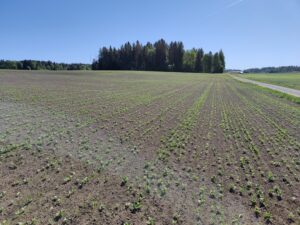
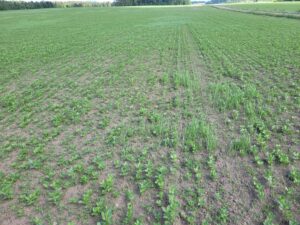
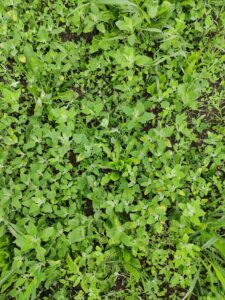


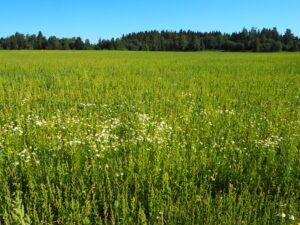
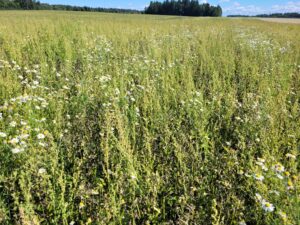
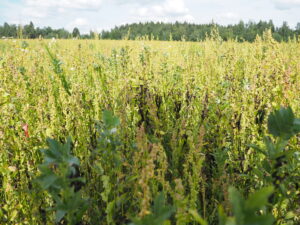
Cultivation activities
Silage grass
10.6.2021 Harvesting silage, yield 3452 kg dm/ha
15.-16.6.2021 Fertilizer, slurry cow manure 40 tn/ha
19.6.2021 Mowing (nature protection field)
21.6.2021 Swathing and bailing (nature protection field), yield 2307 kg dm/ha
23.7.2021 Harvesting silage, yield 713 kg dm/ha
5.-6.8.2021 Plowing 3,5 ha
6.8.2021 Harrowing, plate harrow
6.8.2021 Harrowing, goosefoot harrow
6.-7.8.2021 Sowing: autumn fava bean Augusta 300 kg/ha, autumn canola Legato 2,65 kg/ha, autumn canola Aita 2,7 kg/ha
18.9.2021 Harvesting silage (4,9 ha), yield 689 kg dm/ha
28.10.2021 Plowing, 4,9 ha
Field scanning: Riuskanoja
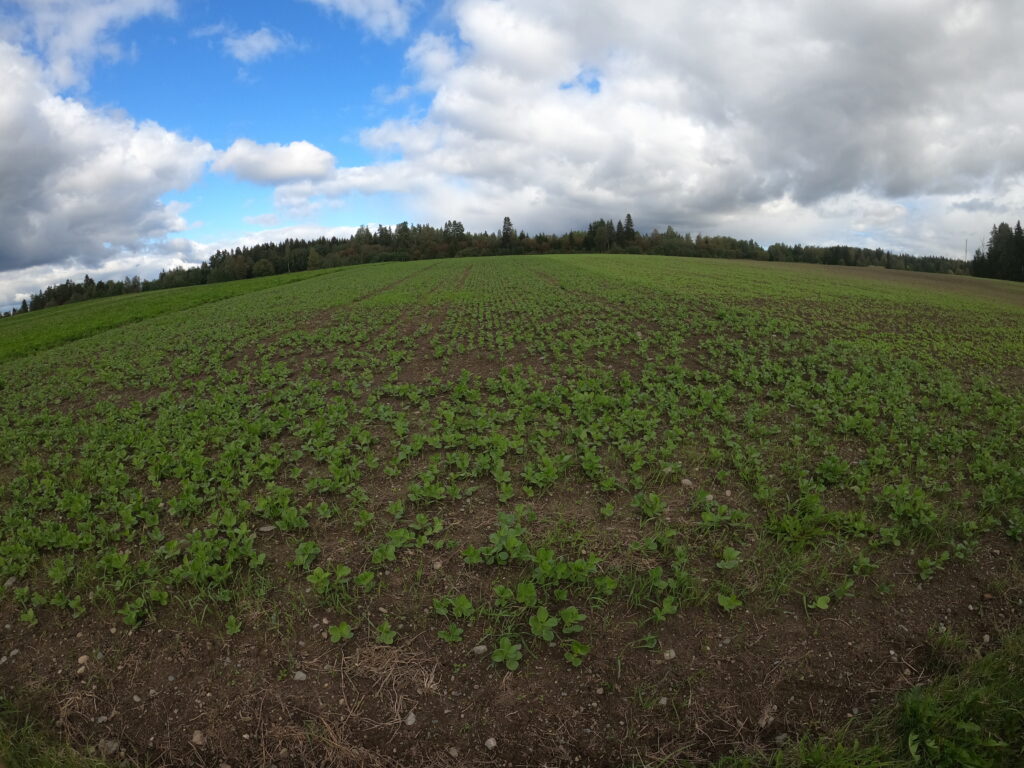
Cultivation activities
Spring wheat, Helmi
27.4.2020 Harrowing, evening the soil
4.5.2020 Fertilizer, slurry cow manure 34 tn/ha, slurry cow manure 22 tn/ha, slurry cow manure+Ecolan Agra 3-0-0 vinasse 22 tn/ha (fertilizer experiment with different fertilizers and levels of nitrogen)
5.-6.5.2020 Harrowing, goosefoot harrow
6.5.2020 Sowing, spring wheat Helmi 280 kg/ha
3.6.2020 Harrowing the weeds, sowing tall fescue-clover grass mixture 20kg/ha
19.-20.8.2020 Threshing, yield 3323 kg/ha
21.8.2020 Collecting straws
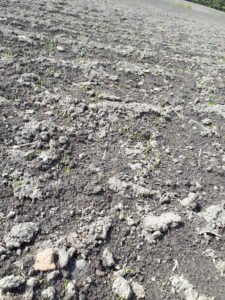
20.5.2020 Wheat has come to the surface only here and there
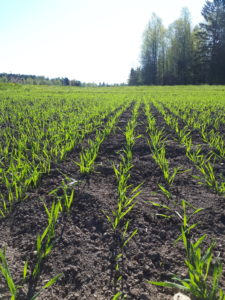
26.5.2020 Wheat sprouts have started growing well
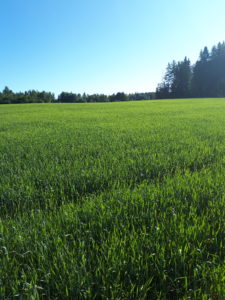
22.6.2020 Growth on the block participating on competition “Käytännön Maamiehen Satokisa” seems reasonably good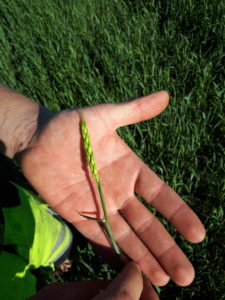
22.6.2020 Wheat is spiking
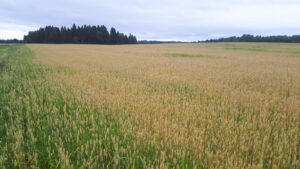
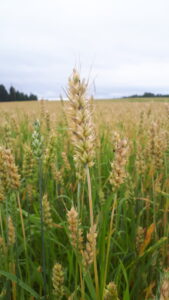
Two upper photos 3.8.2020. Growth doesn’t have much to complain about
Weed research

21.5.2020
1. Harrowing the weeds from the test batches, sowing grass mixture Mustiala 2019
3. Blind cultivation
3.6.2020
2. Harrowing the weeds, sowing grass mixture Mustiala 2019
4. Harrowing the weeds, sowing grass mixture Mustiala 2019 and a bit of scentless camomille
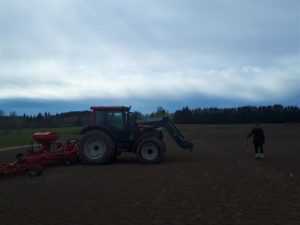
21.5.2020 Harrowing the weeds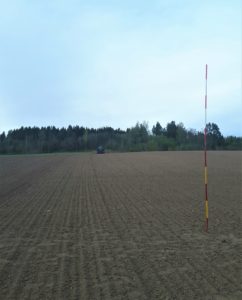
21.5.2020 Harrowing the weeds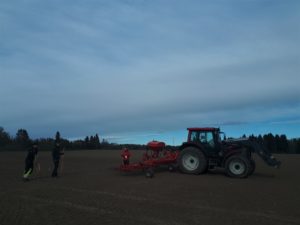
21.5.2020 While harrowing the weeds from the experimental lanes it is good to have some extra hands
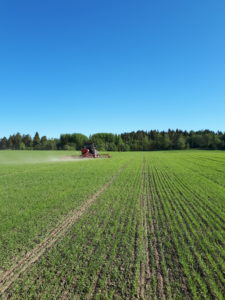
3.6.2020 Harrowing the weeds from the test batches

Temperature curves from the field. Green is temperature of the air, orange soil temperature from 20 cm depth and blue 50 cm depth.
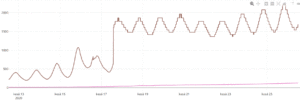
The soil moisture from the same place, the graph is showing values in kPa in different depths (20 cm and 50 cm). Most significant change has happened on 17.6., when the soil has clearly dried in 20 cm depth. In 50 cm depth, the change has been more moderate (luckily).
KM yield competition
Mustiala’s teaching and research farm is participating to KM yield competition with wheat Helmi. The competition area is on the east edge of the field, but the more precise area of 1 ha will be determined closer to harvest.
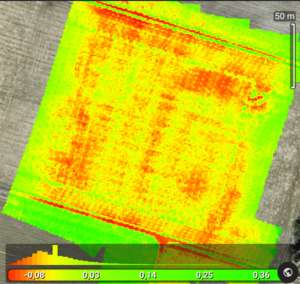
2.6.2020 KM yield competition filed as VARI-index image. The more green color, the more growth. At the moment, it seems that the best areas would be on the lower edge of the area, on the right and on the upper corner on left.
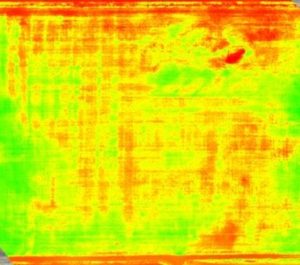
230620 In the competition area, the greenest parts are changing as the growing season is going further. Now the picture has been cropped to show only the area flown.
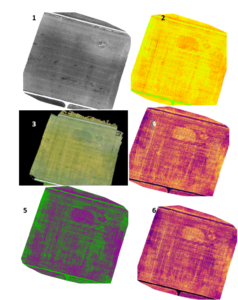
230720 Picture taken from the competition field, which has been modified with Pix4D-program. Still the middle part of the east edge is giving best place for the competition
Kuva1: filtered for blue color and bw-image from it. Couch grass places can clearly be seen in the growth.
Kuva2: picture showing the amount of color green
Kuva3: normal colored picture shown in dot cloud
Kuva4: filtered with multiple colors
Kuva5: filtered only with two colors; green is showing good growth and purple worse
Kuva6: filtered with 20 different colors. Picture gets more precise, but does not give extra value for interpretation.
Nature protection field
22.6.2020 Mowing
22.-25.6.2020 Tedding
26.6.2020 Baling the dry hay
Fertility analysis 5.5.2023 experiment area.
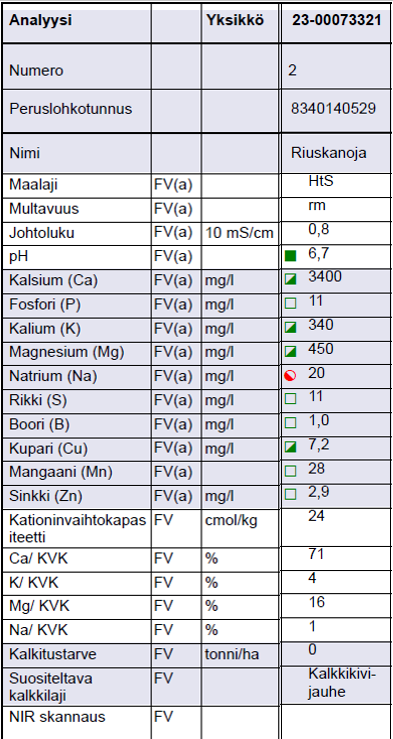
Fertility analysis 27.11.2020:
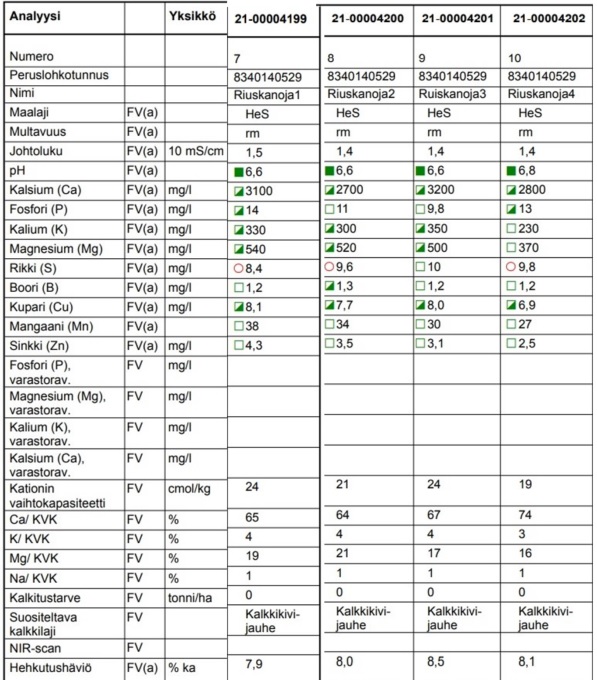
Vocabulary for reading fertility analysis:
Numero= number
Peruslohkotunnus= basic field id-number
Nimi= name
Maalaji= soil type
Multavuus= type of humus
Johtoluku= electrical conductivity
Kationinvaihtokapasiteetti= cation exchange capacity
Kalkitustarve= need for liming
Suositeltava kalkituslaji= recommended lime type
Hehkutushäviö= annealing loss
NIR skannaus= NIR scanning
Yksikkö= unit
Tonni= ton
Vapaavalintainen= free choice
Soil NIR-analysis (18.9.2020)
Sampling line 2020:
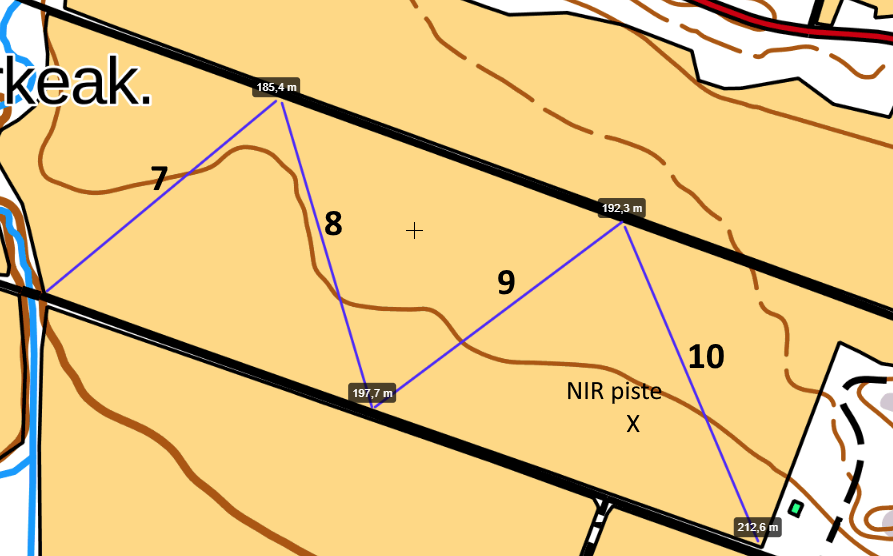
2021 Silage grass
2019 Barley, Elmeri
2018 Barley, Elmeri
2017 Autumn wheat, Arktika
2016 Pea, Ingrid
2015 Spring wheat, Quarna
2014 Perennial grass, silage and grazing
2013 Perennial grass, silage and grazing
2012 Perennial grass, silage and grazing
2011 Oat Aslak and grass seed mixture
2010 Sugar beet, Hamilton Pancho Beta
